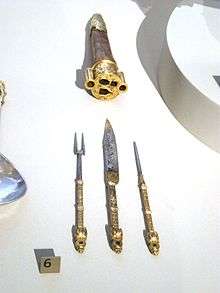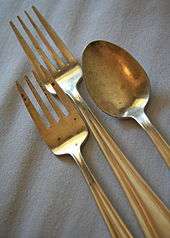Cutlery

Cutlery includes any hand implement used in preparing, serving, and especially eating food in the Western world. A person who makes or sells cutlery is called a cutler. The city of Sheffield in England has been famous for the production of cutlery since the 17th century and a train – the Master Cutler – running from Sheffield to London was named after the industry.[1]
Cutlery is more usually known as silverware or flatware in the United States, where cutlery usually means knives and related cutting instruments. Although the term silverware is used irrespective of the material composition of the utensils, the term tableware has come into use to avoid the implication that they are made of silver.
The major items of cutlery in the Western world are the knife, fork and spoon. In recent times, hybrid versions of cutlery have been made combining the functionality of different eating implements, including the spork (spoon / fork), spife (spoon / knife), and knork (knife / fork) or the sporf which combines all three.
Etymology

The word cutler derives from the Middle English word 'cuteler' and this in turn derives from Old French 'coutelier' which comes from 'coutel'; meaning knife (modern French: couteau).[2]
The first documented use of the term "cutler" in Sheffield appeared in a 1297 tax return. A Sheffield knife was listed in the King's possession in the Tower of London fifty years later. Several knives dating from the 14th century are on display at the Cutlers' Hall in Sheffield.[2]
Composition
Sterling silver is the traditional material from which good quality cutlery is made (hence the usage of the term in the United States). Sets of such cutlery are a valuable component of household silver and are stored and maintained carefully. Whole sets are created, sometimes specifically for wealthy clients, containing a range of specialised dining implements, such as the comprehensive set in sterling silver made for the French aristocrat Marie-Joseph Paul Yves Roch Gilbert du Motier (known as the Marquis de Lafayette) by the Towle Manufacturing Company. It contained, among many other items, a gravy ladle, mustard spoon and lettuce fork.[3]

Steel was always used for more utilitarian knives, and pewter was used for some cheaper items, especially spoons. From the nineteenth century, electroplated nickel silver (EPNS) was used as a cheaper substitute; nowadays, most cutlery, including quality designs, is made from stainless steel. Another alternative is melchior, a nickel and copper alloy, which can also sometimes contain manganese. It also contains elements of magnesium and copper sulphate.
Plastic cutlery is made for disposable use, and is frequently used outdoors for camping, excursions, and barbecues for instance. Plastic cutlery is also commonly used at fast-food or take-away outlets and provided with airline meals in economy class. Wooden disposable cutlery is also available as a biodegradable alternative.
The industry
Cutlery has been made in many places. In Britain, the industry became concentrated by the late 16th century in and around Birmingham and Sheffield. However, the Birmingham industry increasingly concentrated on swords, made by "long cutlers", and on other edged tools, whereas the Sheffield industry concentrated on knives.
At Sheffield the trade of cutler became divided, with allied trades such as razormaker, awlbladesmith, shearsmith and forkmaker emerging and becoming distinct trades by the 18th century.
Before the mid 19th century when cheap mild steel became available due to new methods of steelmaking, knives (and other edged tools) were made by welding a strip of steel on to the piece of iron that was to be formed into a knife, or sandwiching a strip of steel between two pieces of iron. This was done because steel was then a much more expensive commodity than iron. Modern blades are sometimes laminated, but for a different reason. Since the hardest steel is brittle, a layer of hard steel may be laid between two layers of a milder, less brittle steel, for a blade that keeps a sharp edge well, and is less likely to break in service.
After fabrication, the knife had to be sharpened, originally on a grindstone, but from the late medieval period in a blade mill or (as they were known in the Sheffield region) a cutlers wheel.
Disposable cutlery
Introduced for convenience purposes (lightweight, no cleanup after the meal required), disposable cutlery made of plastic has become a huge worldwide market. Along with other disposable tableware (paper plates, plastic table covers, disposable cups, paper napkins, etc.), these products have become essential for the fast food and catering industry. The products are emblematic of throw-away societies and the cause of millions of tons of non-biodegradable plastic waste.
Manufacturing centres
Traditional centres of cutlery-making include:
- Albacete in Spain
- Sheffield in the United Kingdom
- Solingen in Germany
- Thiers and Laguiole in France
- Wazirabad in Pakistan
- Oneida, New York in United States
See also
- Cutler (disambiguation)
- Eating utensil etiquette
- Steak knife
- Table setting
- Tableware
- List of eating utensils
- List of food preparation utensils
- Sujeo
References
- ↑ British Pathé. "The Master Cutler". britishpathe.com.
- 1 2 The Sheffield Knife Book, Geoffrey Tweedale, The Hallamshire press, 1996, ISBN 1-874718-11-3
- ↑ An account of the life of Marie Joseph Paul Yves Roch Gilbert Dumotier, marquis de La Fayette ..: with illustrations of the La Fayette pattern of sterling silver tableware. Newburyport, Mass: Towle Mfg. Company. 1907. p. 67.
Further reading
- Hey, D. The Fiery Blades of Hallamshire: Sheffield and Its Neighbourhood, 1660–1740 (Leicester University Press 1991). 193–140.
- Lloyd, G. I. H. The Cutlery Trades: An Historical Essay in the Economics of Small Scale Production. (1913; repr. 1968).
External links
| Look up cutlery in Wiktionary, the free dictionary. |
| Wikimedia Commons has media related to Cutlery. |
- Associazione culturale Coltellinai Forgiatori Bergamaschi - Research laboratory on damascus steel